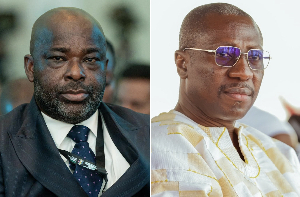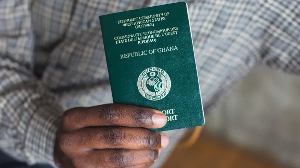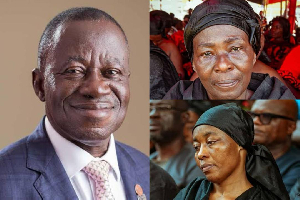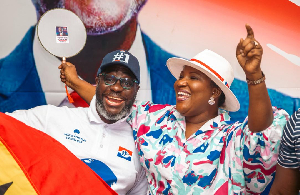Part 1
What was the nature of crimes Nkrumah committed to warrant chains of pre- and post-independence terroristic acts against his person, Ghanaians, and Ghana? This is one important question followers of the Danquah-Busia Tradition conveniently avoid. Significantly, there have been several attempts by keepers of the Danquah-Busia Tradition to tell a grossly distorted history of the PDA, since Nkrumah’s departure from the political scene, ostensibly with no discernible success because the truths of history have not allowed revisionist fabrications to take hold of public consciousness. In other words, they massage Ghana’s political history to fit a certain narrative of moral convenience in which antecedence or precedence, history, or context loses its value in the scientific evaluation of facts, especially when these facts have the potential to assail or prick their conscience for whatever reason(s).
Historical, selective, or social amnesia is their lot, their forte. For that reason, common sense, comparative methodology, scientific grasp of global history and of Ghana’s political historiography, and source criticism, among others, do not feature in their methodological strategies. Our contention is that it is not possible discussing the Patriot Act, for instance, without situating it in the broader contexts of America’s foreign policy, national security concerns, and Military-Industrial complex; the geopolitics of the Middle East; September 11; international terrorism; Congressional practices; ideological conflicts among Judaism, Christianity and Islam; Guantanamo Bay Detention Camp controversies; human rights; renditions; history, imperialism, and Orientalism; patriotism; and international law. Yet ideas and phenomena do not drop out of the clear blue sky. Certainly ideas and phenomena have history, antecedence, or context.
It is, therefore, important to place them [ideas and phenomena] in their proper contexts if their meaningful reconstructions for national reconciliation and improving understanding of the world have any success of enhancing human relations. This is necessary when it becomes apparent that the Preventive Detection Act (PDA), for instance, cannot stand apart from the turbulent period of 1955 to its enactment in 1958. Yet, those Danquah apologists who discuss the PDA have actually elected to do so not in the proper context of Danquah’s lawful imprisonment on account of it, as if Danquah’s life was more precious than Nkrumah’s and hundreds of others and Ghana, but also that the general good it did for Ghana, Africa, and the larger world, including saving the lives of thousands of children and of innocent men and women, is largely ignored for political or ideological expedience.
That notwithstanding, the root cause for the PDA’s enactment traces to September 19, 1954 when the National Liberation Movement (NLM), a terrorist, secessionist, and ethno-regional organization, was formed in Kumasi under the leadership of Busia and Okyeame Akoto Baffoe. The major reasons given for the NLM’s formation include protection of property rights vis-a-vis cocoa farmers and political quest for federalism as opposed to unitary governance. However, a closer examination of the facts reveals an underlying motive that goes beyond what are in the public domain. It turns out the masses had rejected the Opposition at the polls and thus formation of the NLM offered individuals in the Opposition an opportunity to redeem themselves. The Opposition began calling Nkrumah “a dictator, a Fuehrer” after the CPP vanquished it in the 1951 elections. Busia lost in his hometown, Wenchi, where his brother was a traditional ruler. Danquah, the so-called Doyen of Ghana Politics, lost to his relative Aaron Ofori Atta, later a Minister for Local Government and the Minister for Justice in the CPP government, in Central Akyem Abuakwa. Obetsebi-Lamptey and S.G. Antor both lost in Accra and the Volta Region respectively. Thus, the NLM became a front for political losers like Busia and Danquah to revive their political careers. It is in this context that Prof. Ninsin’s statement “But the aim was not to liberate the country but themselves as a group from imminent political extinction” must be understood.
Finally, formation of the NLM saw leading members of the CPP, namely Joe Appiah, R.R. Amponsah, Kurankyi Taylor, Victor Owusu, J.C. De Graft Johnson, defecting to it [NLM]. The NLM would later form political alliances with the Togoland Congress (TC) and the Ga Shifimo Kpee, led by S.G. Antor and Obetsebi-Lamptey respectively, the Northern People’s Party (NPP), the Muslim Association Party (MAP), the Ghana Congress Party (GCP), and the Asante-based CPP rebels. Nevertheless, we should not overlook the fact that the NLM had support from some powerful quarters, including the Asanteman Council, Ofori Atta ?? and Okyeman Council, Asantehene Nana Agyeman Prempeh ?? [and the Asante Youth Association (AYA)]. The British Cocoa-buying company Cadbury and Fry financially supported it, as was the chiefs in council who pledged the movement £20,000, to be taken out of the Asantehene Palace Fund.
Regrettably, the birth of the NLM extended the anticipated date for the Gold Coast’s independence by a year or so, 1956 instead of 1957. The kind of terrorism which the movement and its affiliates unleashed on the country explains the delay. Labelling the CPP government’s position to use cocoa revenue to develop the country as “misrule and dictatorship of the CPP,” to borrow Prof. Ninsin’s phraseology, the Opposition embarked on a series of secessionist and terrorist campaigns to impose federalism on the would-be nation-state’s political economy thinking that was the only way each region could control and appropriate its resources for regional self-development. But this argument has larger political implications for nation-building, as we stated elsewhere in respect of the ulterior motives of Danquah, Busia, etc., to make Nkrumah and the CPP government unpopular, and the country ungovernable. Elsewhere, Danquah and Ofori Atta ?? threatened to bomb voters in Akyem Abuakwa should they [voters] vote for the CPP and to ensure peace never reigned in Akyem Abuakwa, for as long as the reverse of voters’ intentions to vote for the CPP did not happen (see Dr. Botwe-Asamoah’s book “Kwame Nkrumah’s Politico-Cultural Thought and Policies”).
Yet, interestingly enough, the Colonial Government watched as the NLM’s violence against Nkrumah, citizens, and the CPP continued. According to Dr. Biney, Nkrumah introduced Proclamation Eight on May 25, 1955, a piece of legislation which “demanded all arms and munitions be surrendered to the Kumasi police,” upon which police enforcements were dispatched to the region. The violence continued in spite of these developments. But putting everything aside, was the NLM a truly peaceful movement as keepers of the Danquah-Busia Tradition claim? Mr. Nelson and Dr. Gyamerah cite Dennis Austin to show how an altercation between E.Y. Baffoe and K.A. Twumasi Ankrah, N.LM. and C.P.P. supporters respectively, led to the former’s stabbing death on October 9, 1955, thus placing the origins of pre-independence political violence at the feet of this infamous incident. This account oversimplifies the political causation of the altercation. It turned out “Baffoe and a gang of the NLM ‘Action Troopers’ had chased him [Twumasi] to a room, where he stabbed the former with a knife in self-defence” (our emphasis; see Adamafio). Twumasi was subsequently charged with murder, tried in a colonial court, and executed. Related to Baffoe’s death was the birth of the NLM “Action Troopers,” which Dr. Biney otherwise calls NLM “Action Groupers.”
Following this incident, the leadership of the NLM began spreading rumors that Nkrumah and the leadership of the CPP had instigated Twumasi. Yet while the leaders of the NLM portrayed the CPP as a violent political party, it painted the NLM as a peaceful organization. Then again, Mr. Nelson and Dr. Gyamerah quote from a memorandum written by R.J. Vile, the Assistant Secretary and Head of West Africa Department B at the Colonial Office. In this memorandum he [Vile] said of the NLM and its membership: “It is, however, clear that they have a fair amount of dynamites at their disposal and presumably can easily obtain fresh supplies by theft from the mines. They contain a number of thugs who are prepared to use knives and arms of precision. Reports were current in Kumasi a fortnight ago that the NLM had been smuggling in rifles and machine-guns, and there were other reports that small bands of people were being trained with the object of sending them to Accra to attack, and possibly, murder Gold Coast Ministers.” It also turned out elements within the Colonial Government operating the Obuasi mines had been secretly giving out dynamites to these terrorists to destabilize the country in hopes of creating conditions to justify the return of white rule, recolonization.
Vile made those observations in March 1955, some six months prior to the Twumasi-Baffoe incident, thus contradicting the NLM’s self-described accolade as a peaceful organization. As well, Vile’s observations have contextual backing from Busia who, in Dr. Botwe-Asamoah’s words, “had warned the British government that a CPP victory in the 1956 election would be disastrous for the nation, and that the NLM was prepared to seek any means necessary, including terrorism and undemocratic means, to eliminate the evil CPP” (see also Prof. Kofi Awoonor’s “GHANA: A Political History from Prehistory to Modern Times”). In addition, Prof. Ninsin shows the links between the various attempts made by individuals to overthrow the CPP government, the NLM’s iron will to assassinate and/or drive out Nkrumah and his government, and so forth. Elsewhere in Prof. Ninsin’s essay Basil Davidson quotes Dr. Busia in that regard: “As far as we can see (this would lead to a road that) makes for the country (one) of riot, rebellion, revolution; the road long ago taken by those unhappy countries where one can change only the Head of State or the people who govern by armed insurrection after underground conspiracy and courage” (also see “The Nkrumah Government and the Opposition on the Nation State: Unity vs. Fragmentation” in Kwame Arhin’s edited volume “The Life and Work of Kwame Nkrumah”). These incendiary outbursts and other such by Busia underlined his ideological tendencies toward autocracy, thereby serving as a political tool for intimidating his opponents.
The story does not end there, however. Dr. Ama Biney also writes: “The political violence in the country continued with a dynamite explosion at the Central Market in Kumasi on November 17, 1955, and the murder of Krobo Edusei’s sister the following month. By the end of the year, ‘few vestiges remained of a CPP presence in Asante’” (see “The Political and Social Thought of Kwame Nkrumah”). To intensify the already-precarious situation in the Ashanti Region, however, mechanisms were put in place to make it possible for the Asantehene Confederacy Council “to arbitrarily destool all Chiefs who ‘supported the CPP,’” Dr. Botwe-Asamoah quotes Bing, with the former adding: “They include Juasohene, Bekyemhene, Juabenhene, Nifahene of Kumase, and Bamuhene also of Kumase.” Kofi Banda, a CPP activist, was shot to death at a rally in Ejisu. CPP ministers and activists faced death threats if they dared set foot in Kumasi. Rather surprisingly, also, rumors circulated that Nkrumah had demanded the sacred Golden Stool merely as a pretext on the part of subversive elements within the Opposition camp to incite the Asante people to wage war against Nkrumah and the CPP (see Prof. Kofi Awoonor’s book).
The terrorism which the NLM unleashed on the CPP led to the closure of its regional office in Kumasi. Having said that, the Kumasi agitations did not stand alone. They interrelated with others such as those of the Accra-based Ga Shifimo Kpee, the Awhiatey-Amponsah-Apaloo conspiracy (1958), and the Togoland Disturbances led by S.G. Antor. Compounding these atrocities was the Opposition’s protracted equivocation on what it was they actually wanted from Nkrumah and the CPP government (see Chapter 5 [“Nkrumah and the Opposition, 1954-1957”] of Dr. Biney’s book for detailed information). For instance, Dr. Biney shows how Nkrumah and the Opposition worked out their differences in what became a white paper, titled “The Proposed Constitution of Ghana,” under the supervision of Secretary of State Lennox-Boyd, in January 1957. According to her, this white paper addressed “many of the NLM’s concerns; namely, regional assemblies and an agreement that an alteration to the constitution to increase the numbers of regions would seek a referendum in the affected region.” Before long Okyeame Baffoe Akoto came up with another excusatory threat, telling A.C. Russell, the chief regional officer, that there was not going to be independence celebrations in Ashanti. All in all, Jean Allman notes: “there was some consensus in Accra between colonial authorities and the CPP on how to respond to events in Asante. There must be reaction, but not over-reaction, quite, reasoned negotiation, BUT MINIMAL COMPROMISES” (our emphasis; see “The Quills of the Porcupine: Asante Nationalism in an Emergent Ghana”).
In spite of the preceding accounts, Nkrumah and his CPP government did their best to give serious attention to Opposition demands. According to Dr. Biney, Nkrumah in 1956 “invited representatives of the NLM executive, Asanteman Council, and other opposition leaders to a roundtable conference to discuss issues raised by the Bourne Report.” As always, the Opposition boycotted it as well as Nkrumah’s second invitation to them. In the process the Opposition also ignored Sir Frederick Bourne, a constitutional expert the Colonial Government had dispatched to the Gold Coast to resolve the impasse between the Opposition and the CPP. Yet, in another instance, NLM supporters pelted Sir Charles Arden-Clarke’s car with stones in Kumasi, when he travelled there to mediate the impasse breeding the violence, with a view to ending it. Overall, Governor Arden-Clarke appreciated Nkrumah’s efforts to resolve the impasse. He notes: “the Prime Minister’s [Nkrumah’s] overtures were statesmanlike efforts and, taken by themselves, deserved success” (see Dr. Ama Biney). Likewise, Vile echoed Arden-Clarke’s observation when he wrote: “On my second interview with the Prime Minister he took a much more reasonable line. He fully understood that it was only too easy to provoke violence in Ashanti and that it was his clear duty to act peacefully and diplomatically.”
Vile’s and Arden-Clarke’s diplomatic statements tie in with Nkrumah’s character. Adamafio made it clear in his book that Nkrumah intervened in the tensions that arose between members of the NLM and of the CPP, when CPP Troopers finally elected to speak the “language” of NLM Action Troopers. According to Adamafio, Nkrumah warned the CPP Troopers not to reciprocate the violence of the NLM Action Troopers. In other words, he [Nkrumah] rather insisted upon non-violence as a response to opposition violence, for he believed working with the Opposition was in the best interest of the nation. This explains why Nkrumah invited Busia and other Opposition members to join his cabinet, an invitation the latter turned down. Nevertheless, other Opposition members accepted his invitation and consequently became part of his government. For instance, J.A. Braimah became the Minister of Communication and Works. E.O. Asafu-Adjaye, a lawyer and a representative of the Ashanti Confederacy Council, became the Minister of Local Government. Later, Asantehene Otumfuo Osei Agyemang Prempeh ?? was on board with Nkrumah and the CPP government after Busia failed to pressure London not to grant independence to the Gold Coast [Note: Dr. Botwe-Asamoah acknowledges Nkrumah as the only leader in Ghana’s entire political history holding the record for appointing the “largest” number of opposition members to his cabinet. In fact Nkrumah did this in addition to encouraging responsible and effective opposition].
The question for us to address at this juncture in spite of the preceding statements is: Why did Nkrumah not unleash the Ghana’s Armed Forces on the ethnic-based NLM and its vicious supporters, quashing their violence as the Governor-General authorized Ghana’s Armed Forces to do as in the case when S.G. Antor and his thugs declared war on the eve of independence? Let us recall here that, according Dr. Botwe-Asamoah, “Until July 1, 1961, the three main instruments of the government of Ghana, namely, the military, police...were in the hands of British expatriates.” Thus, Nkrumah’s internal government was constitutionally and logistically constrained to effectively respond to the NLM’s terrorism and other instances of armed insurrection. More specifically, in 1951, when Nkrumah became the Leader of Government Business the constitution prevented him from appointing individuals to the positions of Finance and Justice, Attorney General, Defence and External Affairs. The Governor’s veto power also held sway over Nkrumah’s internal government. Yet Dr. Biney cites from R.J. Vile’s 1955 memorandum where Nkrumah had told the former “that Ashanti only understood the language of force.” Unfortunately, the Opposition had an agenda to frustrate Nkrumah’s government from doing the best for the nation. Simply put, the terrorism, secessionism, coup d’états, and assassinations Nkrumah’s enemies hatched out were resolute strategic political calculations meant to undermine popular association with Nkrumah and the CPP, a nationalist, Pan-Africanist political party with a mass following. Dr. Kwame Botwe-Asamoah gives the following chronology of events (see Part 3 of “Kwame Nkrumah: The One and Only Founding Father of Ghana”) justifying for a stronger response such as the PDA. We present them as follows:
1) Dr. K. A. Busia and the NLM warned the British government in August of 1955 of grisly after-effects, if the country attained independence under the CPP government. Hence, the Danquah-Busia camp resorted to the undemocratic methods and terrorist acts and bomb attacks to overthrow the democratically elected government of Kwame Nkrumah, before and after Ghana’s independence.
2) On November 10, 1955, Nkrumah’s house was bombed while he was resting and working in his house with his secretary and others because of a terrible cold.
3) On the day that the CPP reopened its regional office in Kumasi after fourteen months of closure, Prof. Busia’s NLM drove a jeep past the crowd and fired shots into it and wounded several people; it also killed a pregnant woman. Earlier, Krobo Edusei’s sister had been shot dead as she was preparing food in the backyard for her children; while Edusei’s wife had survived a bomb blast.
4) On the eve of Ghana’s Independence on March 6, 1957, the Ewe Unificationists, led by S.G. Antor (Danquah’s buddy), formed themselves into a ragged guerrilla army in Alavanyo and prepared for armed insurrection with homemade guns against the CPP government. The Governor-General sent troops to the region to put down the revolt. Yes, S. G. Antor (J. B. Danquah’s loyal buddy, an ally of Prof. Busia, and one of President Kufour’s heroes) by his (Antor’s) terrorist acts.
5) In 1958, there was a plot to assassinate Nkrumah at the airport and then overthrow the CPP government as Nkrumah was about to leave for a state visit to India. The plot was discovered and the plotters were arrested.
6) Dr. Danquah’s intention to have Nkrumah eliminated from the political scene, after the declaration of Positive Action, lies in his unapologetic statement that Nkrumah will pay with his neck. Danquah would later become an ally of the CIA (Note: Recall Danquah’s speech at the Belawashi coup plot; see Dr. Botwe-Asamoah’s “Kwame Nkrumah’s Politico-Cultural Thought and Policies” and Richard Mahoney’s “JFK: Ordeal in Africa”).
7) Acts of extreme vandalism were perpetrated in Ashanti but particularly in Kumasi, where members of the CPP were chased and ambushed down like animals in broad daylight. Party Adherents fled to Accra and other Southern towns and their houses were dynamited, burned, or turned into places of convenience. The NLM organized what they called ‘Action Troopers.’ These were armed gangs who raided CPP strongholds and killed indiscriminately or destroyed properties at will. Law and order had virtually broken down in Kumasi (see Tawia Adamafio’s “By Nkrumah’s Side: The Labour and the Wounds”).
Here are Mr. Nelson’s and Dr. Gyamerah’s take on the subject under discussion (see their joint essay “The Origins of Preventive Detention”):
1) Less than a year after independence, and after three defeats at the polls in 1951, 1954 and 1956, four prominent members of the U.P. were involved in either undermining the stability of the new Ghana or planning a coup to overthrow the C.P.P. government.
2) In 1958, Modesto Apaloo and R.R. Amponsah (General Secretary of the N.L.M, and later the opposition parties, UP) were implicated in plotting the first coup in the new Ghana with Captain Awhiatey, Commandant of the Gifted Camp (now Burma Camp). The Granville Sharp Commission reports the following: “Amponsah and Apaloo since June 1958, were engaged in a conspiracy to carry out at some future date in Ghana an act for unlawful purpose, revolutionary in character.”
Elsewhere, the Majority Report of the Commission quoted Sir Tsibu Darku and Mr. Maurice Charles as saying: “that Awhiatey, Mr. Amponsah, Mr. Apaloo, and Mr. John Mensah Anthony, were engaged in a conspiracy to assassinate the Prime Minister, Dr. Kwame Nkrumah, and carry out a coup d’etat...” Major General A.G. V. Paley, the British Officer in charge of the Ghana Armed Forces [Chief of Defence Staff], later corroborated the connection between Awhiatey and the Opposition by showing that Awhiatey used Victor Owusu’s “green Wolseley car.” This car was involved in an accident and Amponsah had it repaired. Finally, the National Liberation Council (NLM) appointed Victor Owusu as Attorney General after the 1966 coup.
3) “In the period immediately preceding Awhiatey’s arrest there has been rumours of an army coup d’etat and there was even a Special Branch report in regard to it. It source was a conversation in a foreign Embassy in Accra which had been allegedly overheard by a non-Ghanaian guest who reported it to the police. According to this report, Dr. J.B. Danquah had been heard assuring a diplomat that Dr. Kwame Nkrumah would be overthrown by Christmas by the Army. In view of the status of the informant, the report was taken seriously enough by the Special Branch and General Paley for there to be a thorough investigation made as to whether there was any possibility of the army planning a coup d’etat” (see Geoffrey Bing’s “Reap the Whirlwind”).
4) The violence did not, however, end there: Numerous attempts were made on Nkrumah’s life in years following the introduction of the PDA, including the infamous Kulungugu bomb outrage, the bomb outrages in late 1961 that preceded the visit of Her Majesty Queen Elizabeth 11 in 1962, and the repeated assassination attempts on Nkrumah’s life, a death toll of 30 Ghanaians, men, women and children, had been recorded with the wounding of some 300 others.
We ask again: Why did the Colonial Government generally remain nonchalant in the face of Opposition violence? Part of the reason the Colonial Government chose to remain nonchalant may be deduced from South Africa’s Dr. Motsoko Pheko’s commentaries on Africa’s political history, colonialism, imperialism, and neo-colonialism. Dr. Pheko believes the British never liked Nkrumah, his nationalist and Pan-Africanist politics, and for that reason the British Colonial Government gave in to demands for independence only when “the Gold Coast became ungovernable” (see “Democracy and Legitimacy in Africa,” New African Magazine, Sept. 18, 2013).
We shall return...
Opinions of Thursday, 5 March 2015
Columnist: Kwarteng, Francis














